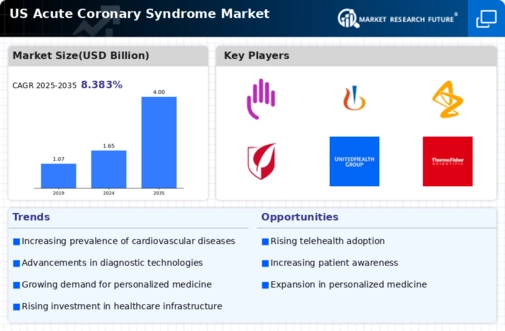Rising Healthcare Expenditure
The upward trend in healthcare expenditure in the US is a significant driver for the acute coronary-syndrome market. With healthcare spending projected to reach $6 trillion by 2027, there is a growing allocation of resources towards cardiovascular care. This increase in funding allows for the adoption of advanced technologies and treatments, enhancing the overall quality of care for patients with acute coronary syndrome. The acute coronary-syndrome market is likely to see a surge in demand for innovative solutions, as healthcare providers strive to improve patient outcomes while managing costs effectively.
Growing Awareness and Education
There is a notable increase in public awareness regarding heart health and the symptoms of acute coronary syndrome. Educational campaigns by health organizations and non-profits are effectively informing the population about risk factors and the importance of early intervention. This heightened awareness is likely to lead to more individuals seeking medical attention promptly, thereby driving demand within the acute coronary-syndrome market. As patients become more informed, healthcare providers may also adapt their practices to meet the evolving needs of the population, potentially leading to an increase in screening and preventive measures.
Advancements in Medical Technology
Technological innovations in medical devices and treatment methodologies are significantly influencing the acute coronary-syndrome market. The introduction of advanced imaging techniques, such as cardiac MRI and CT angiography, enhances diagnostic accuracy, allowing for timely interventions. Furthermore, the development of minimally invasive procedures, such as percutaneous coronary interventions, has transformed treatment protocols. The market is projected to experience substantial growth, with estimates suggesting a valuation of over $10 billion by 2026. These advancements not only improve patient care but also reduce hospital stays and associated costs, making them attractive to healthcare providers and patients alike.
Government Initiatives and Funding
Government initiatives aimed at reducing cardiovascular disease mortality rates are pivotal for the acute coronary-syndrome market. Programs such as the Million Hearts initiative, which aims to prevent 1 million heart attacks and strokes by 2027, highlight the commitment to improving heart health. Increased funding for research and public health campaigns is likely to enhance awareness and early detection of acute coronary syndrome. The acute coronary-syndrome market may benefit from these initiatives, as they encourage the development of new therapies and technologies, ultimately leading to better patient outcomes and reduced healthcare costs.
Increasing Prevalence of Cardiovascular Diseases
The rising incidence of cardiovascular diseases in the US is a primary driver for the acute coronary-syndrome market. According to the CDC, approximately 697,000 individuals die from heart disease annually, accounting for 1 in every 5 deaths. This alarming statistic underscores the urgent need for effective diagnostic and therapeutic solutions. As the population ages and lifestyle-related risk factors such as obesity and diabetes become more prevalent, the demand for acute coronary-syndrome interventions is expected to grow. The acute coronary-syndrome market is likely to see increased investments in research and development to address these challenges, potentially leading to innovative treatment options and improved patient outcomes.

















Leave a Comment